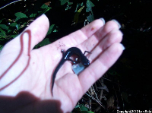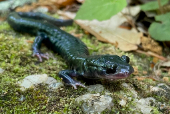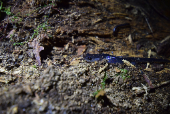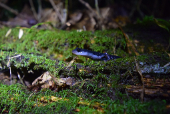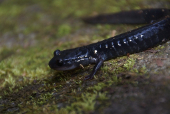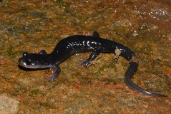South Mountain Gray-Cheeked Salamander (P. meridianus)
Description: They are best identified by using either the collection locality, or a combination of collection locality and genetic markers in areas where the forms come into close geographic contact. All are relatively large Plethodon species that are dark gray to bluish black above with grayish venters. The tail of the adult is slightly longer than the body and is rounded in cross-section. Sexually-active males have conspicuous, rounded mental glands. The adults vary from 8.5 to 18.5 cm TL and there are usually 16 costal grooves.
Habitat: This species inhabits mesic forest, and individuals are often under leaf-litter, logs, or mossy rocks. It is a terrestrial breeder with direct development in the same habitat. It tolerates some level of disturbance because much of its range occurs in second growth forest. Individuals are more active under moist conditions, and likely move underground to avoid dry and cold extremes.
Range: This species can be found in the South Mountains, in Burke, Cleveland, and Rutherford counties, in the Piedmont Province of North Carolina. Its elevational range is approximately 543 to 823 m asl.
Found in these States:
NC
Diet: Unreported, but as with other species of Plethodon, animals likely feed at night, with activity proportional to moisture levels. Prey items include small invertebrates, especially insects, that inhabit or are associated with the forest floor. Invertivore.
Reproduction: Terrestrial breeder. The nests of Plethodon meridianus have never been found, but gravid females of other members of the P. jordani complex move underground in late spring or early summer and presumably oviposit in deep underground recesses. Females of members of the P. jordani complex appear to oviposit in May in the southern Appalachians based on the presence or absence of gravid females in samples. Hatching probably occurs in late summer or early autumn about 2 to 3 months after the eggs are deposited.
Status: Listed as Endangered because its extent of occurrence (EOO) is 1,257 km2, it occurs in five or fewer threat-defined locations, and there is continuing decline in the extent and quality of its habitat in North Carolina, USA.
»» Kingdom: Animalia - Animals
»» Phylum: Chordata - Chordates
»» Subphylum: Vertebrata - Vertebrates
»» Class: Amphibia - (Amphibians)
»» Order: Caudata - Salamanders
»» Family: Plethodontidae - Lungless Salamanders
»» Genus: Plethodon
»» Species: P. meridianus - South Mountain Gray-Cheeked Salamander
This article uses material from the Wikipedia article "South Mountain Gray-Cheeked Salamander", which is released under the Creative Commons Attribution-Share-Alike License 3.0. Content may have been omitted from the original, but no content has been changed or extended.
|



